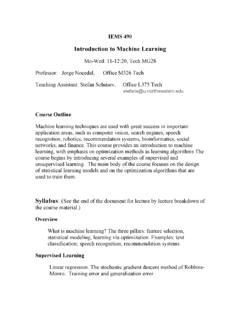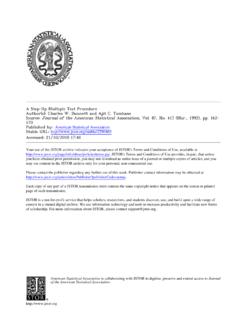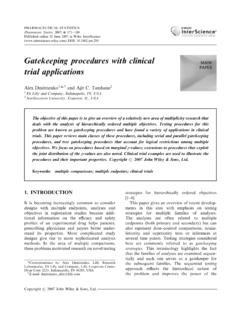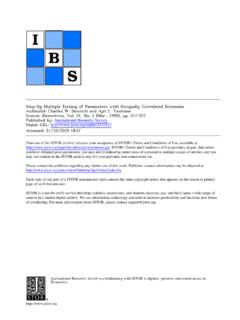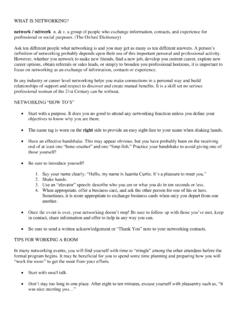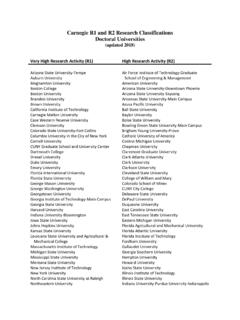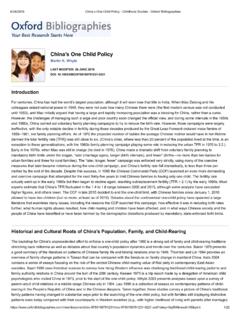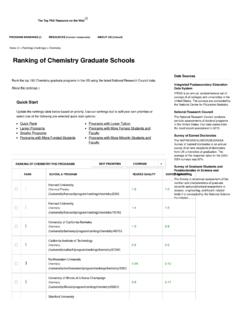Transcription of Midterm 1 Practice - Northwestern University
1 Midterm 1 Practice Problems 1. Calculate the present value of each cashflow using a discount rate of 7%. Which do you most prefer most? Show and explain all supporting calculations! Cashflow A: receive $60 today and then receive $60 in four years. Cashflow B: receive $12 every year, forever, starting today. Cashflow C: pay $50 every year for five years, with the first payment being next year, and then subsequently receive $30 every year for 20 years. Cashflow D: receive $9 every other year, forever, with the first payment being next year. 2. Consider a project costing $1m each year from year 1 to year T. Then starting in year T+1, the project will generate a profit of $700k each year, forever. a) Write a formula for the present value of this project with a discount rate of r. b) Write a formula in terms of r for the value of T at which you break even (ignoring the issue of whether T is an integer). 3. Suppose you had $10,000 to invest for one year.
2 You are deciding between a savings account with a 2% annual interest rate compounded daily (alternative A) and one with a 2% annual interest rate compounded monthly (alternative B). You are about to invest in the alternative A, but then you realize that since that bank is in downtown Chicago, you ll need to spend an extra $1 for parking when opening the account. Alternative B does not have this cost (it s a bank in Evanston). Should you change your decision or stick with alternative A? Show and explain all supporting calculations! 4. What is the effective annual interest rate in each situation? a. A savings account with 4% annual interest rate compounded daily (assume a year consists of 365 days)? b. A savings account with 4% annual interest rate compounded monthly? 5. Consider the following cashflow stream and a bank account paying 3% annual interest. What is the present value? Is the account value ever negative? Year Cashflow 0 8 1 2 2 4 3 -15 4 16 6.
3 Which of the following cashflows do you most prefer using a discount rate of 10%? Using a discount rate of 1%? Show and explain all supporting calculations! Cashflow A: receive $10 every year, forever, with the first payment next year Cashflow B: receive $19 every other year, forever, with the first payment being next year Cashflow C: pay $5 every year for 20 years, with the first payment being today, and then subsequently receive $30 every year for 20 years. Cashflow D: receive $70 today and then receive $50 in five years. 7. Irene Engels recently graduated with an MBA. In August 2007, she borrowed $50,000, and she borrowed another $50,000 in August 2008. Her student loan has an annual interest rate of 2% compounded monthly. Irene doesn t make any payments on her student debt until she starts a lucrative Wall St. job. Then starting in September 2009 she makes a payment of $1000 every month. Now bonus time is coming near.
4 For January 2010 she plans to make another $1000 payment (her 5th) and also apply her bonus to the debt. How big must her bonus be so that she will have completely paid-off the debt at the end of this January? 8. You are analyzing the value of the company Twitter using a 15% discount rate. You expect its cashflows over the next 4 years to be as shown below and you estimate its NPV as $1B. Explain. Year Cashflow 0 -20M 1 -10M 2 0 3 12M 4 40M 9. A bank offers a savings account with a 3% annual interest rate, compounded monthly. What is the effective annual interest rate? Stu wants to open a savings account and make one deposit now that will enable him to withdraw $700 to go on vacation 5 months from now and $2000 for a deposit on a rental apartment when he starts working in 20 months from now. How much money does Stu need to deposit now? 10. If the discount rate is 12%, what is the present value of receiving $1000 per year at the end of each of the next 8 years?
5 11. Using a discount rate of 5%, what is the net present value of the following cashflow stream? Year Cashflow 0 -20 1 2 2 4 3 8 5 16 12. You bought a $200k condo. You got a 15-year fixed-rate mortgage and made a 20% down payment. a) What is your monthly payment? b) Would the monthly payment be bigger or smaller with a 30-year mortgage at the same interest rate? 13. Consider the following cashflow stream and a bank account paying 10% annual interest. Today the account has $9. Year Cashflow 1 -4 2 +3 3 -1 What is the largest amount ever in the account? 14. Calculate the PV of the following cashflows using a 7% discount rate. a) 30 payments of 100 starting 5 years from today b) you pay 10/yr for 3 years with the first payment being today, and then starting a year from today you will receive $6/yr for 6 years. 15. Suppose that a construction project costs $10m (in present value) if you start it today. What are the savings (in present value) of delaying it by 3 years.
6 Assume a 10% discount rate and that the price remains the same. 16. A 1% monthly rate of return is equivalent to what annual rate (compounded yearly)? 17. You ve taken out a 30-year mortgage for 120k with a rate. a) What s your minimum monthly payment? b) You ve paid $700/mo for one and a half years. You re now trying to refinance. What s the principal remaining on your mortgage? 18. You and two friends are considering buying a house in Chicagoland to live here together after you graduate. You can get a 15-year fixed-rate mortgage with a mortgage rate of 5% if you make a 20% down payment on the house. You will split the monthly mortgage payment equally among the three of you. Each of the three of you can afford to contribute up to $1,000 per month towards the mortgage payment. You each have $10,000 available towards the down payment. How expensive a house can you afford to buy? 19. For all the parts to this problem, let the annual discount rate be 5%.
7 A) Find the present value of the following cashflow: receive $10 every year for 30 years with the first payment being 10 years from now. b) Find the present value of the following cashflow: receive $10m now and the same amount a year from today and pay $3m a year forever with the first payment being a year from today. c) Consider the following two cashflows. For cashflow A, you receive $10 every year for 5 years with the first payment being today. For cashflow B, you receive x dollars every year forever with the first payment being today. What is the value of x in order for cashflow B to have the same present value as cashflow A? 20. Today, you re in charge of the nation s finances. Suppose that projected 2015 shortfall is $418 billion and projected 2030 shortfall is $1,345 billion. In present value terms, how large is the difference of the two budget shortfalls?
8 Assume a 3% discount rate. 21. Suppose that you borrowed $20k for 36 months to buy a car last year at an annual interest rate of 5% compounded monthly. a) What is the amount of monthly payment? b) Calculate the effective annual interest rate for both the car loan and for a rate of 6% compounded quarterly. Which is larger? c) You made monthly payments for the last 12 months. But you still have to make 24 more payments. What is the present value of the remaining payments? 22. Suppose that you consider some mortgage options. The price of home is $200k. Calculate your monthly payments for each option: - Option A: 20% down payment at 15-year fixed annual rate of 4% - Option B: 15% down payment at 30-year fixed annual rate of - Option C: 10% down payment at 30-year fixed annual rate of 6% 23. Suppose that an account has $6m now.
9 The money is invested and obtains a return of 2%. Your business projections are that in year one you take out $2m, in year two you take out $ , in year three you add $1m to the account, and in year four you add $4m to the account. Calculate the amount of money in the account a year from now, two years from now, three years from now, and four years from now. 24. Consider a 30-year mortgage with a 5% interest rate and a 20% down payment. If you can afford a $1000 monthly payment, how expensive a house can you buy? 25. Suppose you decide to buy a $200,000 condo. You make a 10% down payment and take out a 30-year fixed-rate mortgage at 6%. a) What is your monthly payment? b) Suppose in three years the rate for a 15-year fixed rate mortgage is 5%. What would your new monthly payment be if you decided to refinance then? 26. For all the parts to this problem, let the annual discount rate be 3%. a) Find the present value of the following cashflow: receive $13,240 every year for 20 years with the first payment being 45 years from now.
10 B) Consider the following cashflow: receive x dollars now and the same amount in a year from today, and pay $300k a year forever with the first payment being a year from today. What is the value of x in order for the present value of the cash flow to be 0? 27. Consider a stimulus program that intends to spend $300 billion every year, for three years. Assuming a 3% discount rate, a) what is the present value of the program? b) how much would the present value increase if the $300 billion were spent at the beginning of each year rather than at the end? 28. You are running a small business. At the beginning of the month you have $1000. At the end of the first week you have revenues of $2200 and expenses of $1000 for that week. In the second week your revenues are $2000 and your expenses are $700. In the third week your revenues are $2100 and your expenses are $1100. In the fourth week, your revenues are $2200 and your expenses are $3000 (they are higher as you need to pay the rent).


